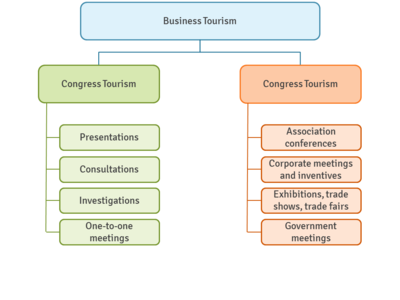Business tourism: Difference between revisions
(Infobox update) |
mNo edit summary |
||
| Line 19: | Line 19: | ||
Leisure activities are also part of business tourism. However they are not main motive for travel, they are important part of services as individuals who travel in [[work]] related affairs [[need]] to relax after the meetings, exhibition, speeches, [[need]] to eat and drink as any other kind of tourists. Hotels dedicated to business tourists have usually spa and sport facilities. | Leisure activities are also part of business tourism. However they are not main motive for travel, they are important part of services as individuals who travel in [[work]] related affairs [[need]] to relax after the meetings, exhibition, speeches, [[need]] to eat and drink as any other kind of tourists. Hotels dedicated to business tourists have usually spa and sport facilities. | ||
[[File:business_tourism.png|400px|right|thumb|Fig.1. Types of business tourism (source: based on Inbakaran et al.)]] | |||
==Characteristics of business tourism== | ==Characteristics of business tourism== | ||
| Line 39: | Line 40: | ||
* Davidson, R. (1994). ''[http://www.cabdirect.org/abstracts/19941807100.html Business travel]''. Pitman Publishing Limited. | * Davidson, R. (1994). ''[http://www.cabdirect.org/abstracts/19941807100.html Business travel]''. Pitman Publishing Limited. | ||
* Hankinson, G. (2005). ''Destination [[brand]] images: a business tourism perspective''. Journal of Services [[Marketing]], 19(1), 24-32. | * Hankinson, G. (2005). ''Destination [[brand]] images: a business tourism perspective''. Journal of Services [[Marketing]], 19(1), 24-32. | ||
* Inbakaran, Robert & George, Babu & Jackson, Mervyn & Melo, FRE. (2012). ''Identifying resort tourism market segments based on visitor demographics: a study''. Academica Turistica. 5. 85-94. | |||
* Lawson, F. R. (1982). ''Trends in business tourism [[management]]''. Tourism Management, 3(4), 298-302. | * Lawson, F. R. (1982). ''Trends in business tourism [[management]]''. Tourism Management, 3(4), 298-302. | ||
Revision as of 15:40, 31 August 2020
| Business tourism |
|---|
| See also |
Business tourism is a natural development of growing global economy and need to international cooperation. As a number of business travels increased significantly over the years, it was necessary to name for this phenomenon of travelling, categorize it as type of tourism. Globalization was one of the factors that led to state where business trips are popular and necessary in global economy. Nowadays business tourism is one of the fastest growing form of tourism and has a significant role on global market.
Generally travelling for meetings, trade fairs, incentive travels, attending conferences abroad and exhibitions creates phenomenon of business tourism and first letters of those four words - meetings, incentive, conferences and exhibitions make popular used abbreviation and name for business tourism - MICE.
Leisure activities are also part of business tourism. However they are not main motive for travel, they are important part of services as individuals who travel in work related affairs need to relax after the meetings, exhibition, speeches, need to eat and drink as any other kind of tourists. Hotels dedicated to business tourists have usually spa and sport facilities.
Characteristics of business tourism
- low price-sensitivity,
- highly profitable type of tourism,
- there's no visible seasonality,
- quality of service in business tourism is very high,
- income from business tourism is on the same level during the whole year, with small decrease during holiday season,
- concentrate mostly in and around big cities.
Effects of business tourism on tourism market
Business class created by different airlines is one of examples where tourism market adjusted to the needs of business tourists. Another visible example is that whole hotels are built for business needs. They are well-appointed, located near main routes and in city centers, well-equipped for conferences and meetings with big halls and rooms for exhibitions purposes.
See also:
References
- Davidson, R. (1994). Business travel. Pitman Publishing Limited.
- Hankinson, G. (2005). Destination brand images: a business tourism perspective. Journal of Services Marketing, 19(1), 24-32.
- Inbakaran, Robert & George, Babu & Jackson, Mervyn & Melo, FRE. (2012). Identifying resort tourism market segments based on visitor demographics: a study. Academica Turistica. 5. 85-94.
- Lawson, F. R. (1982). Trends in business tourism management. Tourism Management, 3(4), 298-302.
Author: Emilia Maciejczyk
